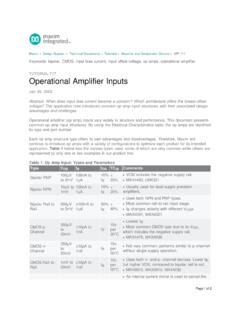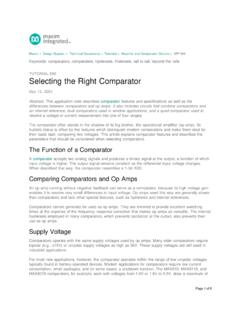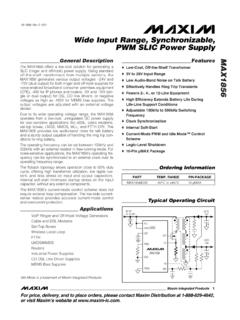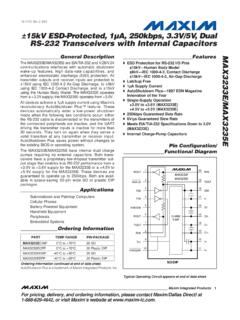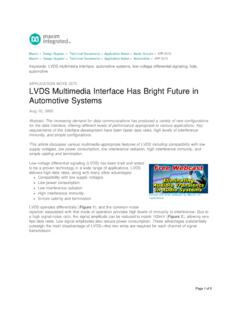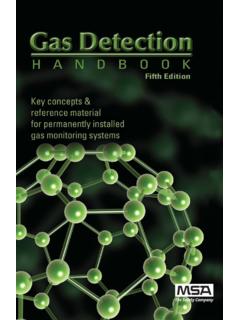Transcription of Thermal Management Handbook - Maxim Integrated
1 Thermal ManagementHandbook Revised March 2014 Introduction: Thermal Management in Electronic 3 Temperature-Sensing 4 4 NTC 4 7 9 Temperature sensor 13 Analog Temperature sensor 13 Local Digital Temperature sensor Other Digital Temperature sensor Remote Digital Temperature 21 Remote Temperature sensor Error 23 Other Remote sensor 26 Other Types of Thermal Management 28 Temperature 28 Fan Speed 31 Types of Controlling Fan Minimizing the Effects of Fan Speed Control on Acoustical Monitoring Fan 37 Closed-Loop RPM 41 Fan Controller Temperature 42 Closed-Loop, Temperature-Based ( Thermal Closed-Loop) Fan Speed Lookup Table Mapping of Temperature and Fan No-MCU Fan Signal Conditioners for Non-IC Temperature 44 Thermistor RTD Thermocouple 46 Using Thermal Management Components Principles and Application Sensing Location.
2 The Key to Choosing the Right sensor Remote Diode sensor 53 PC Board Layout Guidelines for Remote Thermal Diode Design 55 Application RTD-to-Digital 56 Thermocouple Interface 60 IR-Linked Temperature 62 RS-232-Powered Temperature 63 Fan Control 64 Fan Control Pulse-Width-Modulated, Fan Power-Supply 4-Wire Fan 71 Converting PWM Control Signals to Linear Fan Linear Fan High-Voltage Fan 48V, 4-Wire Fan Speed 75 48V, PWM Power Supply Fan Speed 48V, Linear Fan Speed 1 On/Off Fan Control Basic On/Off Fan Controllers Using Temperature 77 Simple, Two-Speed Fan 80 Fan Fail-Safe Temperature 82 In-Circuit Temperature Switch Thermal Additional 84 Application Notes, Tutorials, and Reference 84 2 Introduction: Thermal Management in Electronic Systems Thermal Management in electronic systems is done for one or more of the three purposes outlined below.
3 1. Control Temperature data is an input to a large number of control systems. The control system may be as simple as an on/off thermostatic controller for room temperature, which activates a heater whenever the temperature drops below a specific threshold. Or it may be a complex fan speed control system that uses measured temperature to adjust the speeds of several fans to ensure adequate cooling of system components, while changing fan speeds in such a way as to minimize the audibility of the changes. 2. Calibration Temperature data is used to correct temperature-dependent errors in a component. Calibration functions can be implemented simply using an analog temperature sensor with an operational amplifier circuit, or they may be much more complex with a lookup table that provides a 12-bit correction factor every 5 C for a data acquisition system. For example, a TCXO uses temperature to adjust the operating parameters of a crystal oscillator to compensate for the shift in the crystal s resonant frequency over temperature.
4 Signal conditioners for sensors such as pressure transducers use temperature data to correct for thermally induced drift in the transducers characteristics. 3. Protection Many components in electronic systems can be exposed to temperature extremes from ambient conditions, power dissipation in nearby components, or their own power dissipation that can damage them. Thermal Management components can be deployed to detect, and in some cases eliminate, potentially dangerous Thermal conditions before they can cause damage. Again, these solutions can be as simple as an over-/under-temperature detector to protect circuit board components from damage, or as complex as a cooling system that uses temperature data from multiple locations to ensure proper operating temperature under a variety of external conditions. This Handbook provides an introduction to Thermal Management devices and illustrates some of the ways in which they may be used.
5 3 Temperature-Sensing Technologies Thermal Management begins with the measurement of temperature. Maxim manufactures a wide variety of temperature-sensing ICs for such measurement. In addition to the various types of IC sensors, there are several other technologies that enable temperature to be measured by electronic systems. Some of the more widely used approaches are discussed in this section. Application circuit examples can be found later in this Handbook , in the section titled Using Thermal Management Components Principles and Circuits. Thermistors Thermistors are temperature-dependent resistors, usually made from conductive materials such as metal-oxide ceramics or polymers.
6 The most common thermistors have a negative temperature coefficient (NTC) of resistance and, therefore, are often referred to as NTCs. Positive temperature coefficient thermistors, known as PTCs, are also available. Characteristics include moderate temperature range (generally up to +150 C, though some are capable of much higher temperatures), low-to-moderate cost (depending on accuracy), poor but predictable linearity, and some signal conditioning required. Thermistors are available in probes, in surface-mount packages, with bare leads, and in a variety of specialized packages. Maxim manufactures ICs that convert thermistor resistance to a digital format. A common approach to using a thermistor for temperature measurement in shown in Figure 1, where a thermistor and fixed-value resistor form a voltage divider whose output is digitized by an analog-to-digital converter (ADC). Figure 1. This basic circuit shows how a thermistor can interface to an ADC.
7 Resistor R1 and the thermistor form a voltage divider with a temperature-dependent output voltage. NTC Thermistors NTCs are the most commonly used thermistors for measurement applications. Usually molded from metal-oxide semiconductor materials, they have a large negative temperature coefficient. The relationship between resistance and temperature for a common NTC is shown in Figure 2. Note the nonlinearity of the resistance vs. temperature curve. 4 (a) (b) Figure 2. Resistance vs. temperature curves for a standard NTC . Nominal resistance is 10k at +25 C. Note the nonlinearity and large relative temperature coefficient of curve (a). Curve (b) is based on a logarithmic scale and also exhibits significant nonlinearity. 5 Note that the nonlinearity of NTCs introduces a difficulty when a wide range of temperatures must be measured.
8 Because the slope of the curves in Figure 2 decreases significantly at temperature extremes, the effective temperature resolution of any ADC used with the NTC will be degraded at those extremes. This may require the use of a higher resolution ADC if a wide range of temperatures must be measured Combining an NTC with a fixed resistor in a voltage-divider circuit like the one in Figure 1 provides some linearization, as shown in Figure 3. By selecting an appropriate value for the fixed resistor, the temperature range for which the curve is most linear can be shifted to meet the needs of the application. Figure 3. Making an NTC voltage-divider, as in Figure 1, helps to linearize the NTC s resistance curve over a limited temperature range. The voltages on the NTC and the external resistor, R1, are shown as a function of temperature. Note that the voltage is roughly linear from 0 C to +70 C. The accuracy specifications for NTCs vary significantly.
9 At one end of the spectrum are very low-cost thermistors that are guaranteed only at a single temperature. The components are capable of giving a rough indication of temperature within a few degrees of the actual value at the guaranteed temperature and no guarantee at other temperatures. At the other end are significantly more expensive, interchangeable thermistors that are guaranteed to a fraction of a degree accuracy over a wide range of temperature. 6 RTDs Resistance temperature detectors (RTDs) are resistors whose resistance varies with temperature.
10 Platinum is the most common, most accurate wire material; platinum RTDs are referred to as Pt-RTDs. Nickel, copper, and other metals may also be used to make RTD characteristics include a wide temperature range (up to roughly 800 C), excellent accuracy and repeatability, reasonable linearity, and the necessity for signal conditioning. Because of their accuracy, stability, and wide temperature range, platinum RTDs are used in a variety of precision applications, including instruments, process control, and automotive systems. For Pt-RTDs, the most common values for nominal resistance at 0 C are 100 and 1k , though other values are available. The average slope between 0 C and +100 C is called alpha ( ). This value depends on the impurities and their concentrations in the platinum. The two most widely used values for alpha are and , corresponding to the IEC 751 (PT100) and SAMA standards. The resistance vs.
